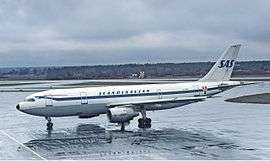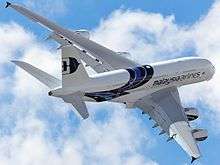Malaysian Airline System Flight 684
|
OY-KAA, the aircraft involved in the accident, at Stockholm Arlanda Airport in 1982 | |
| Accident summary | |
|---|---|
| Date | 18 December 1983 |
| Summary | CFIT (controlled flight into terrain) due to pilot error in bad weather |
| Site |
Kuala Lumpur Subang International Airport (KUL/WMKK), Malaysia 3°9′12.54″N 101°32′10.98″E / 3.1534833°N 101.5363833°ECoordinates: 3°9′12.54″N 101°32′10.98″E / 3.1534833°N 101.5363833°E |
| Passengers | 240 |
| Crew | 7 |
| Survivors | 247 (all) |
| Aircraft type | Airbus A300B4-120 |
| Aircraft name | Stig Viking |
| Operator | Malaysian Airline System |
| Registration | OY-KAA |
| Flight origin | Singapore-Changi International Airport (SIN/WSSS), Singapore |
| Destination | Kuala Lumpur Subang International Airport (KUL/WMKK), Malaysia |
Malaysian Airline System Flight 684 was an international flight from Singapore Changi Airport, Singapore to Kuala Lumpur-Subang International Airport, Kuala Lumpur, Malaysia. On 18 December 1983 the Airbus A300 operating the flight crashed 2 km short of the runway at Kuala Lumpur Airport, Malaysia with no fatalities among the 247 passengers and crew.[1][2]
Accident
Malaysian Airline System Flight 684 departed Singapore Changi Airport in Changi, Singapore on 18 December 1983 at 18:53 local time. As the flight approached Subang International Airport (now Sultan Abdul Aziz Shah Airport) in Subang, Selangor, Malaysia at 19:20 local time, it was cleared for an instrument landing despite poor runway visibility of 450 m (1,480 ft) due to rain. Airline policy required visibility of at least 800 m (2,600 ft), but the pilot assumed control from the first officer and began his descent. Furthermore, the air crew did not turn on the Instrument Landing System on the aircraft due to increased workload which was exacerbated further due to the different cockpit switch configuration between the A300 owned by Malaysia Airlines & that of the crashed aircraft, which was leased from Scandinavian Airlines System.[3]
The altimeter warning sounded and within 30 seconds the aircraft struck trees 2 km (1.2 mi) short of the runway. The plane slid along the ground for 436 m (1,430 ft), skipped for 36 m (118 ft), and finally struck a stream embankment where it slid another 109 m (358 ft) before coming to rest. The aircraft was still 1,200 m (3,900 ft) short of the runway and had lost its landing gear and both engines.[1]
All 247 passengers and crew survived, evacuating the aircraft before the fire destroyed it.
Probable cause
The probable cause was ascribed to pilot error in not monitoring descent rate during approach in Instrument Meteorological Conditions (IMC) and continuing an approach below company minima without sighting the runway.[4]
References
- 1 2 Jon Livesey (17 July 2014). "Curse of Malaysia Airlines? 5 tragic moments in airline's history before MH17 and MH370". Daily Mirror.
- ↑ "Accidents and incidents of Malaysia Airlines". China Daily. 8 March 2014.
- ↑ The Naked Pilot: The Human Factor In Aircraft Accidents, David Beatty
- ↑ Malaysia Airlines Flight 684 report "Malaysia Airlines Flight 684" Check
|url=value (help). ASN. Retrieved 1 February 2014.

